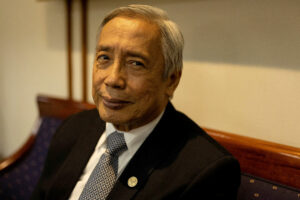




Philippines Trade Update: Trade trajectories trend along
 DOWNLOAD
DOWNLOAD

Policy Rate Updates: Double cut finale
 DOWNLOAD
DOWNLOAD

Monthly Economic Update: One for the road
 DOWNLOAD
DOWNLOAD


Higher oil prices unlikely to ‘disturb’ BSP inflation outlook, says Medalla

WASHINGTON — The Bangko Sentral ng Pilipinas (BSP) is confident headline inflation will return to within its 2-4% target by the fourth quarter this year amid a recent spike in global oil prices and still-elevated core inflation.
BSP Governor Felipe M. Medalla told BusinessWorld that even though higher global oil prices is an upside risk to inflation, it won’t “disturb” the central bank’s main scenario.
“(Higher global oil prices) is one of our upsides. The risk is still there. If something happens… oil becomes the battleground again. But our main scenario won’t be disturbed by this event,” Mr. Medalla said in an interview at the sidelines of the International Monetary Fund and World Bank spring meetings here.
He said the central bank still sees inflation going below 4% by November or December this year, before normalizing in 2024.
“Why the confidence? In the past, inflation has a natural tendency to normalize precisely because the central bank is acting on it. In fact, inflation has normalized starting February,” he said in mixed English and Tagalog.
Inflation slowed for a second straight month to 7.6% in March from 8.6% in February. Still, March marked the 12th month in a row that inflation exceeded the central bank’s 2-4% target band.
The average inflation rate in the first quarter stood at 8.3%, still above the BSP’s full-year forecast of 6%.
Since May last year, the Monetary Board raised benchmark interest rates by 425 basis points (bps), bringing the key policy rate to a near 16-year high of 6.25%.
“If we have three very low month-on-month (inflation), then we’re more confident that inflation has peaked in January, and it will continue to normalize. But again, we have to be vigilant that something can happen,” Mr. Medalla said.
Inflation rose to 8.7% in January, the highest in 14 years.
BSP Deputy Governor Francisco G. Dakila, Jr. told BusinessWorld in the same interview that global oil prices may drive up food costs, which may fuel inflation.
Global oil prices spiked earlier this month following the announcement by the Organization of the Petroleum Exporting Countries and their allies including Russia, of further output target cuts of around 1.16 million barrels per day from May through the rest of the year.
“So, surprises can come from anywhere, but right now it looks like the worst is over,” Mr. Medalla said, adding that inflation may even go below 2% by January next year due to high base effects.
The BSP chief said he is not worried about elevated core inflation, which hit a 22-year high of 8% in March. Core inflation, which excludes volatile items of food and fuel, has been rising since March 2022.
Mr. Medalla said that although there is a six-month lag, core inflation would historically start to ease if headline inflation is clearly slowing down.
Asked if the Monetary Board will mirror the projected Fed rate cuts this year, the BSP governor said: “Maybe we will, but it’s too soon to say. What’s easier to make sure is we can either – depending on the data in April – we can either pause or maybe do another 25 basis points.”
The US Federal Reserve has been aggressive in its tightening cycle since March last year, raising rates by 475 bps to 4.75-5%. The Fed is scheduled to meet on May 2-3 to discuss policy.
The Monetary Board will meet on May 18.
While the US economy may fall into a recession, Mr. Medalla said a recession is unlikely in the Philippines as consumption is expected to continue to fuel growth.
The government is targeting a 6-7% expansion for this year, slower than the 7.6% growth in 2022. — By Keisha B. Ta-asan, Reporter
This article originally appeared on bworldonline.com





 By BusinessWorld
By BusinessWorld